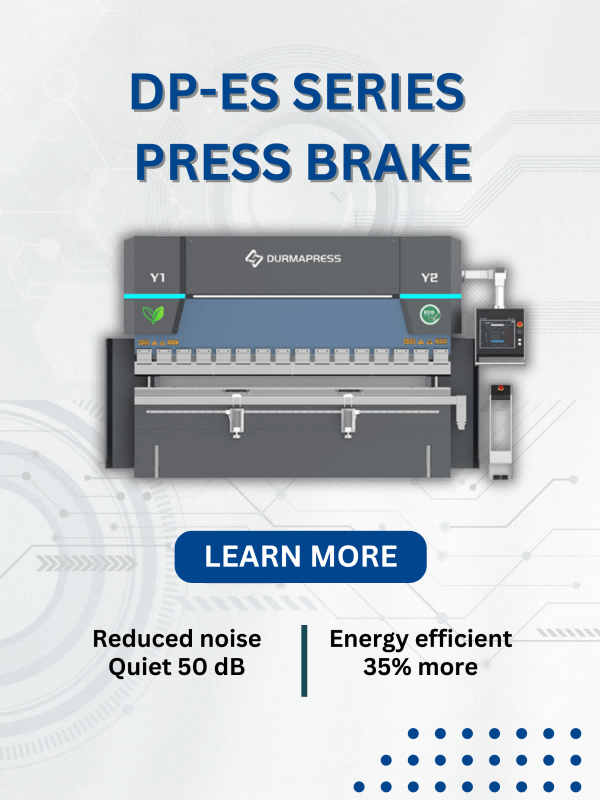
Exploración del trabajo de la plegadora hidráulica CNC sin presión: Guía de solución de problemas

En esta parte, presentaremos en detalle los campos de aplicación de la prensa plegadora hidráulica CNC en la producción industrial moderna y su importancia. Como un equipo mecánico clave en el campo del procesamiento de metales, la prensa plegadora hidráulica CNC es ampliamente utilizada en los procesos de doblado, formado y procesamiento de placas de metal. Su rendimiento de procesamiento preciso, alta eficiencia y funcionamiento estable de la máquina hacen que juegue un papel insustituible en la aviación, la automoción, la construcción, electrodomésticos y otras industrias. Además, también analizaremos en profundidad la composición básica del sistema hidráulico y su función con el fin de proporcionar la base teórica necesaria para la posterior resolución de problemas. El sistema hidráulico se compone principalmente de bombas hidráulicas, válvulas de control, actuadores, tanques, tuberías y aceite hidráulico. Su función principal es transferir energía a través del aceite a presión para realizar el accionamiento y control de diversos equipos mecánicos.

Ampliación detallada de la descripción del fallo
Descripción detallada del fenómeno de fallo: en el proceso de procesamiento mecánico, el deslizador en el trabajo en la fase del fenómeno de presión, lo que resulta en su incapacidad para completar con éxito las tareas programadas de operación de doblado. La ocurrencia de este fenómeno, que afecta gravemente a la eficiencia de la producción y la calidad del producto, la necesidad urgente de análisis de fallos y solución de problemas.

Se describen detalladamente las fases de funcionamiento del sistema hidráulico
- etapa de avance rápido: en esta etapa, el sistema hidráulico proporcionará rápidamente presión a la corredera, de modo que avance rápidamente para alcanzar rápidamente la posición de la pieza, en preparación para la siguiente fase del trabajo en la etapa.
- trabajo en la etapa: en esta etapa, el sistema hidráulico necesita proporcionar una presión continua y estable a la corredera para asegurar que la corredera pueda estar a la velocidad y fuerza adecuadas para llevar a cabo el procesamiento de la pieza, como las operaciones de plegado.
- fase de retorno rápido: tras la finalización del procesamiento de la pieza, el sistema hidráulico reducirá rápidamente la presión, de modo que el ariete vuelva rápidamente a la siguiente ronda de procesamiento.
Descripción detallada del sistema hidráulico y su diagrama de principio de funcionamiento y análisis de componentes clave
El sistema hidráulico es un sistema de transmisión mecánica que utiliza líquido como medio de trabajo y transfiere energía mediante presión. Se compone principalmente de bombas hidráulicas, válvulas de control, actuadores, dispositivos auxiliares y aceite hidráulico cinco componentes principales. El principio de funcionamiento del sistema hidráulico es el uso de bombas hidráulicas para transportar el aceite hidráulico de la región de baja presión a la región de alta presión, y luego a través de la válvula de control para controlar el flujo de aceite hidráulico y la presión, accionar el actuador para completar una variedad de movimientos mecánicos. El sistema hidráulico se caracteriza por una potencia de salida estable, alta precisión de control, velocidad de respuesta rápida y buena fiabilidad, y es ampliamente utilizado en diversas maquinarias de ingeniería, equipos industriales y líneas de producción automatizadas y otros campos.
El diagrama esquemático del sistema hidráulico es una descripción de los componentes del sistema hidráulico y su representación gráfica de la relación de conexión, que incluye principalmente bombas hidráulicas, válvulas de control, actuadores, sensores de presión, caudalímetros y otros componentes. El diagrama esquemático del sistema hidráulico nos ayuda a entender el principio de funcionamiento del sistema hidráulico y la función de cada componente, y nos proporciona una referencia importante para diseñar y mantener el sistema hidráulico.
Los principales componentes de un sistema hidráulico son las bombas hidráulicas, las válvulas de control, los actuadores, los sensores de presión, los caudalímetros, etc. Entre ellos, la bomba hidráulica es la fuente de energía del sistema hidráulico, utilizada para transportar aceite hidráulico de la zona de baja presión a la zona de alta presión; las válvulas de control se utilizan para controlar el flujo de aceite hidráulico y la presión, controlando así el movimiento del actuador; los actuadores son las partes de ejecución del sistema hidráulico, utilizados para completar una variedad de movimientos mecánicos; los sensores de presión y los medidores de flujo se utilizan para controlar la presión y el flujo del sistema hidráulico, proporcionando señales de retroalimentación para el sistema de control.
La válvula solenoide es una parte importante del sistema hidráulico, su secuencia de acción tiene un gran impacto en el efecto de trabajo del sistema hidráulico. La secuencia de acción de la válvula solenoide es usualmente programada y controlada por el sistema de control de acuerdo a la demanda real, para asegurar que el sistema hidráulico pueda trabajar de acuerdo al orden y método predeterminado. La secuencia de acción de la válvula solenoide incluye principalmente la secuencia de energización y desenergización de la válvula solenoide, así como la secuencia de conmutación de la válvula de control conectada a ella. Estableciendo razonablemente la secuencia de acción de la válvula solenoide, el sistema hidráulico puede realizar un control de acción complejo para satisfacer diversas necesidades de ingeniería.

Análisis de fallos y resolución de problemas

Análisis de fallos y solución de problemas es garantizar el funcionamiento normal de la maquinaria y el equipo es un eslabón importante, a través de las posibles causas de fallo para llevar a cabo un análisis detallado y la investigación, puede localizar rápidamente el problema y tomar las medidas adecuadas para hacer frente a ella. Las causas comunes de fracaso incluyen el fracaso del solenoide de la válvula de alivio proporcional, el desgaste o fallo de sellado de la válvula de cartucho, y el fracaso de la válvula de llenado de líquido.
Para garantizar la precisión de la localización de averías, es necesario seguir ciertos pasos. En primer lugar, compruebe si el solenoide de la válvula de alivio proporcional está normalmente activado, si el solenoide no está activado, entonces la válvula de alivio proporcional no puede funcionar normalmente. En segundo lugar, compruebe el desgaste de la válvula de cartucho 2. Si la válvula de cartucho está muy desgastada o el sello falla, causará que la presión del sistema sea inestable. Por último, compruebe el estado de la válvula de llenado de líquido, si la válvula de llenado de líquido está defectuosa, puede provocar una presión insuficiente en el sistema.
En el proceso real de resolución de problemas, descubrimos que la causa principal de la presión insuficiente es el daño en el carrete de la válvula de llenado de líquido. Para resolver este problema, tenemos que modificar la válvula de llenado de líquido o personalizar y comprar una nueva válvula de llenado de líquido. El principio de funcionamiento de la válvula de llenado de líquido es que cuando el deslizador se mueve hacia abajo rápidamente, la válvula piloto se abre y el líquido entra en el cilindro de trabajo, y cuando el deslizador se mueve hacia arriba rápidamente, la válvula piloto se cierra y el líquido en el cilindro de trabajo se comprime, generando así presión.
Durante el proceso de localización de averías, personalizamos y adquirimos una nueva válvula de llenado de líquido y resolvimos el desajuste de la interfaz. Al mismo tiempo, readaptamos la barra superior de la válvula piloto y alargamos la longitud de la barra superior para garantizar que la válvula de llenado de líquido pudiera funcionar correctamente. Antes y después de la modificación, comparamos el diseño estructural de la barra superior para asegurarnos de que la barra superior modificada podía cumplir los requisitos de trabajo.
Tras instalar la nueva válvula de carga y realizar pruebas de funcionamiento, comprobamos la eficacia de la localización de averías. Mediante la remodelación y la resolución de problemas mencionadas, la estabilidad de la presión del equipo mejoró considerablemente y la avería se resolvió con eficacia.
Resuma
En este proceso de localización de averías, planteamos los pasos y métodos básicos de la localización de averías hidráulicas, y también comparamos las ventajas y desventajas de la automodificación y la adquisición personalizada. Sugerimos que, en el futuro, prestemos más atención al mantenimiento y conservación de los equipos y llevemos a cabo la resolución de problemas con regularidad para minimizar la aparición de averías. Al mismo tiempo, para averías similares, deberíamos elegir el método de tratamiento adecuado según la situación específica para garantizar el funcionamiento normal del equipo.
Quiénes somos
Durmapress se especializa en el diseño, la fabricación y la venta de diversos equipos de procesamiento de metales, como plegadoras, cizallas, punzonadoras, máquinas de corte por láser, etc. La empresa se fundó en 2000. Con años de experiencia y acumulación de tecnología. DurmaPress se ha convertido en una de las marcas más conocidas de la industria china de maquinaria para el procesamiento de metales.
Póngase en contacto con nosotros
Entradas recientes
Categorías
Síguenos
Más información
Si tiene alguna información sobre nuestros productos, póngase en contacto con nosotros y le responderemos en 24 horas.



-300x169.jpg)

